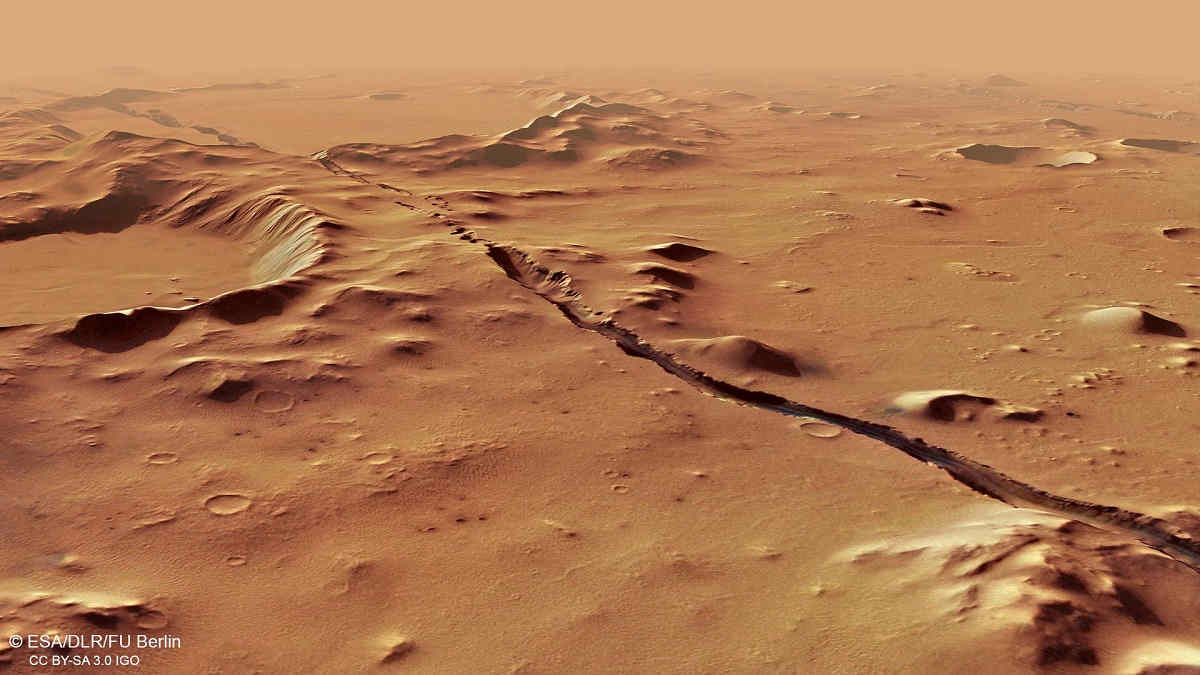11.11.2022
Vulcanism may still play a role in shaping the Martian surface.

One of the fractures (graben) that make up the Cerberus Fossae system. The fractures cut through hills and craters, indicating their relative youth. Credit: SA/DLR/FU Berlin, CC BY-SA 3.0 IGO.
Mars has been shown to be geologically active. Scans show the red planet has pockets under the surface of a potentially “warm” source that could be explained by the existence of molten rock. This would indicate magma at this depth and volcanic activity on Mars.
Until now, Mars has been considered dead, geologically speaking. But the scans show that not only seismic signals, but vulcanism also plays an important role in shaping the Martian surface. Learning about Mars – the only other planet we know of that may once have supported a magnetic field – may help us understand similar geological processes on Earth.
NASA’s InSight lander has been studying Mars’s interior structure since 2018. Among recent discoveries that probe beyond skin-deep impressions of the red planet is a studywhich used seismography to confirm the diameter of Mars’s core (around 3,620 kilometres).
From the same cache of information scientists have revealed a completely new story – potential magma beneath the Martian crust. Their findings are publishedin Nature Astronomy.
Earthquakes on Mars – or marsquakes – with epicentres originating around a region called the Cerberus Fossae, consisting of surface fractures, have been studied by an international team led by seismologists and geophysicists in Switzerland.
Their analysis of deep, low frequency marsquakes suggests a structurally weak, potentially warm region, around 30-50 kilometres beneath the surface. This, they suggest, is consistent with recent magmatic activity at these depths.
Scanning orbital images of the area, the team noticed the marsquake epicentres were very near a structure previously described as a “young volcanic fissure” surrounded by darker dust deposits.
“The darker shade of the dust signifies geological evidence of more recent volcanic activity – perhaps within the past 50,000 years – relatively young in geological terms,” explains lead author Dr Simon Stähler from ETH Zurich University.
“InSight’s (has) the most sensitive seismometer ever installed on another planet,” says Domenico Giardini, a professor at ETH Zurich. “It affords geophysicists and seismologists an opportunity to work with current data showing what is happening on Mars today – both at the surface and in its interior.”
Geophysically speaking, Mars was – 3.6 billion years ago – as active as Earth is today. Volcanic debris on Mars has formed the largest volcanic system in the solar system. The geology includes Tharsis Montes and the solar system’s tallest mountain, Olympus Mons (nearly three times higher than Mount Everest).
The analysis of the quakes at Cerberus Fossae shows there’s a little geological life left in Mars. Stähler believes we are witnessing the last remnants of a once-active volcanic region, or even magma moving eastward to its next location of eruption.
Quelle: COSMOS
